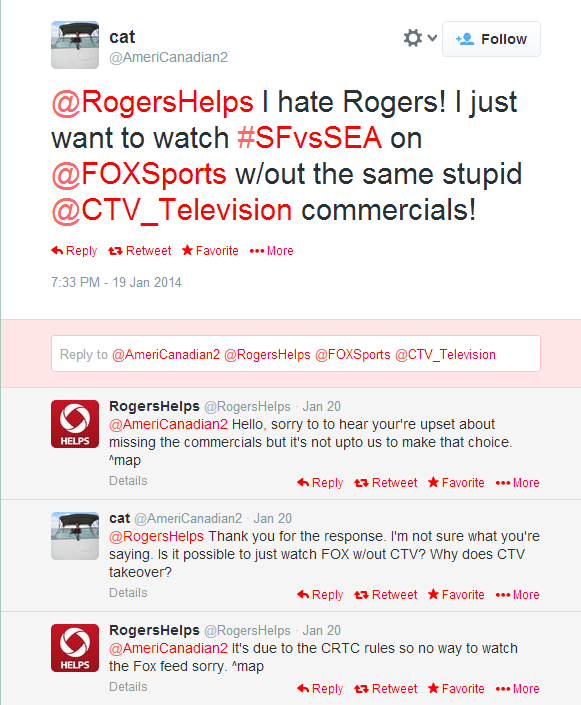On Friday, CRTC chair JP Blais wrote to Rogers, because he was “dismayed” following the NFL playoff game between the San Francisco 49ers and Seattle Seahawks.
It wasn’t that the 49ers lost.
He didn’t like the exchange he read on Twitter:
There was a point in the game where the main broadcaster (Fox) thought that the clock went down to the 2-minute warning, a point in the game where broadcasters can usually pack a few commercials back-to-back. So CTV went ahead and inserted its commercials into the CTV version of the game. But the referee put a second back onto the clock allowing one more play. Fox broke away from their commercial quicker than CTV.
I was upset at that point as well:
What the hell CTV?
— Mark Goldberg (@Mark_Goldberg) January 20, 2014
In his letter, the CRTC wrote:
As you are aware, there are a number of misconceptions and a certain frustration among Canadian television viewers regarding simultaneous substitution. These are often expressed at this time of year—specifically, during the NFL playoffs and following the broadcast of the Super Bowl game.
In fact, the CRTC has a special website just because of regular complaints about Canadians not being able to access Super Bowl commercials.
The CRTC sent a reply tweet a day later, on Monday, to the annoyed user, copying Rogers and CTV:
@AmeriCanadian2 @RogersHelps @FOXSports @CTV_Television Super Bowl TV commercials – why are the ads different? http://t.co/GtDWgTp4YB
— CRTCeng (@CRTCeng) January 20, 2014
The customer replied, “Thank you, I’m informed & appreciate the responses.” Twitter worked!
But apparently, the Chairman didn’t think that the Commission should be taking the heat for its regulations. In his letter to Rogers, the chairman’s letter goes on to state:
Broadcasters have indicated that they benefit tremendously from simultaneous substitution. They have earned many millions of dollars in ad revenues since 1972, when the CRTC first allowed broadcasters to replace American signals with their own. In addition, many television distributors in Canada are now part of the same corporate family as those very broadcasters. As such, members of the broadcasting industry—both broadcasters and distributors—must share in the duty of ensuring that simultaneous substitution is done correctly. They must also share in the responsibility of explaining to Canadians the policy’s benefits and in correcting misinformation in the public sphere.
He goes on to admonish the response from the Rogers social media team:
it would be appreciated if you could remind your customer service representatives that broadcasters choose whether to substitute signals and that both the broadcaster and the distributor are responsible for the quality of the substitution.
Here is the rub. While CTV is part of the corporate family of a TV distributor (Bell), it is not related in any way to Rogers. Rogers involvement in the interaction with the frustrated customer was as a broadcast distributor, obligated by CRTC regulations to insert the CTV feed on top of the Fox channels.
As the first tweet from Rogers said, it wasn’t up to Rogers to make that choice. The customer wanted clarification and the Rogers person correctly stated that it was due to CRTC rules. This had nothing to do with vertical integration and the fact that Rogers also owns broadcast assets. All BDUs in Canada are subject to the same CRTC rules. If the game broadcaster asks for substitution, the BDU has to ignore the fact that its customers may want to see the US feed; as a condition of license, the CRTC requires that the BDU swaps the feed.
Back in 2008, before Bell owned CTV, Bell TV didn’t substitute the CTV feed on the US High Definition broadcast of the 2008 Super Bowl. The CRTC responded harshly:
The Commission expects Bell TV to perform simultaneous substitution of future Super Bowl and similar broadcasts in compliance with the Broadcasting Distribution Regulations, and in the same manner that it regularly performs such substitutions. The Commission also directs Bell TV to confirm in writing, with both the Commission and CTV, within two weeks of the present decision, that it will perform such substitution.
Why did the CRTC target Rogers, the distributor, but not CTV, the broadcaster? Why did the CRTC chair ask Rogers for a “report outlining the training your customer service representatives receive on this issue, as well as copies of fact sheets or other materials at their disposal.”
The tweets from the Rogers social media team appear to be accurate and responsive, considering the 140 character limitations of the medium.
At the end of the day, the CRTC is responsible for its own regulations.

